Promoting Positive Behaviour: Strategies for Healthcare Professionals
VerifiedAdded on 2020/07/22
|8
|1853
|43
Report
AI Summary
This report delves into the critical aspects of promoting positive behaviour within healthcare and social care settings. It begins by outlining the factors that influence an individual's positive behaviour, such as their value systems, cultural background, and personal experiences. The report then explores various interventions designed to alter challenging behaviours and foster positive outcomes. These interventions include prioritizing health conditions, defining goals, developing intervention plans (including functional behavioural analysis and proactive strategies), and establishing evaluation plans. The report also emphasizes the importance of implementing the least restrictive behaviour approaches and the safeguards necessary when using restrictive physical interventions. Furthermore, it highlights the significance of maintaining a user-centered approach when establishing proactive strategies, ensuring that the individual's needs and expectations are at the forefront. The report concludes by outlining the steps to maintain dignity and respect when responding to incidents of challenging behaviour, as well as the preventative measures to be taken prior to such incidents, emphasizing the importance of interviews, evaluations, and counseling to promote positive behaviour.

PROMOTE POSITIVE
BEHAVIOUR
BEHAVIOUR
Paraphrase This Document
Need a fresh take? Get an instant paraphrase of this document with our AI Paraphraser

TABLE OF CONTENTS
INTRODUCTION...........................................................................................................................1
LO 1.................................................................................................................................................1
P1............................................................................................................................................1
P2. Interventions which promote positive behaviour.............................................................1
P3. Explanation of process of implementing the least restrictive behaviour.........................2
P4. Explanation for putting safeguards in place while using restrictive physical interventions.3
LO 2.................................................................................................................................................3
P5............................................................................................................................................3
P6. Importance of maintaining a user centred approach when establishing proactive strategies
................................................................................................................................................3
LO 3.................................................................................................................................................3
P7............................................................................................................................................3
P8............................................................................................................................................3
P9. Steps taken to maintain dignity and respect on individual when responding to an incident
of challenging behaviour........................................................................................................4
P10. Description of the steps to be taken prior to the incident of challenging behaviour......4
CONCLUSION................................................................................................................................4
REFERENCES................................................................................................................................6
INTRODUCTION...........................................................................................................................1
LO 1.................................................................................................................................................1
P1............................................................................................................................................1
P2. Interventions which promote positive behaviour.............................................................1
P3. Explanation of process of implementing the least restrictive behaviour.........................2
P4. Explanation for putting safeguards in place while using restrictive physical interventions.3
LO 2.................................................................................................................................................3
P5............................................................................................................................................3
P6. Importance of maintaining a user centred approach when establishing proactive strategies
................................................................................................................................................3
LO 3.................................................................................................................................................3
P7............................................................................................................................................3
P8............................................................................................................................................3
P9. Steps taken to maintain dignity and respect on individual when responding to an incident
of challenging behaviour........................................................................................................4
P10. Description of the steps to be taken prior to the incident of challenging behaviour......4
CONCLUSION................................................................................................................................4
REFERENCES................................................................................................................................6

INTRODUCTION
Health and social care organisation plays an important role in fulfilling the societal and
medical needs of a user (Allemand, Steiger and Fend, 2015). The factors which promote positive
behaviour of an individual are value system, cultural background and personal experiences.
Positive behaviour in an adult helps in attainment of goals in the best possible manner. This
assignment takes into consideration an understanding of restrictive behaviour in the health and
social care. The strategies which promote positive behaviour are understood and practised in the
report. Lastly, the ways in which positive behaviour is challenged and manipulated is
understood.
LO 1
P1
Covered in Poster
P2. Interventions which promote positive behaviour
Interventions are defined to be an amalgamation of various set of strategies which lead to
influence the behaviour of a person. The intervention plan for healthcare patients are as follows:
Prioritising health
conditions and problems
The health problem which is encountered with clients is a
challenging behaviour. It has been identified that challenging
behaviour can result in physical and emotional injury to an
individual (Salend, 2015).
Definition of and goals and
objectives
The goal in this intervention plan is to alter challenging
behaviour of clients and later into positive outcomes.
Develop intervention Plan Functional behavioural Analysis: It is essential to conduct an
assessment of behaviour of service user so that major grounds
could be identified. This assessment will determine the
behaviour so that suitable interventions could be developed to
improve the same.
Developing of proactive strategies: In healthcare institution, it is
very important to shift focus from reactive approaches to
proactive strategies of interventions (Crone, Hawken and
1
Health and social care organisation plays an important role in fulfilling the societal and
medical needs of a user (Allemand, Steiger and Fend, 2015). The factors which promote positive
behaviour of an individual are value system, cultural background and personal experiences.
Positive behaviour in an adult helps in attainment of goals in the best possible manner. This
assignment takes into consideration an understanding of restrictive behaviour in the health and
social care. The strategies which promote positive behaviour are understood and practised in the
report. Lastly, the ways in which positive behaviour is challenged and manipulated is
understood.
LO 1
P1
Covered in Poster
P2. Interventions which promote positive behaviour
Interventions are defined to be an amalgamation of various set of strategies which lead to
influence the behaviour of a person. The intervention plan for healthcare patients are as follows:
Prioritising health
conditions and problems
The health problem which is encountered with clients is a
challenging behaviour. It has been identified that challenging
behaviour can result in physical and emotional injury to an
individual (Salend, 2015).
Definition of and goals and
objectives
The goal in this intervention plan is to alter challenging
behaviour of clients and later into positive outcomes.
Develop intervention Plan Functional behavioural Analysis: It is essential to conduct an
assessment of behaviour of service user so that major grounds
could be identified. This assessment will determine the
behaviour so that suitable interventions could be developed to
improve the same.
Developing of proactive strategies: In healthcare institution, it is
very important to shift focus from reactive approaches to
proactive strategies of interventions (Crone, Hawken and
1
⊘ This is a preview!⊘
Do you want full access?
Subscribe today to unlock all pages.

Trusted by 1+ million students worldwide
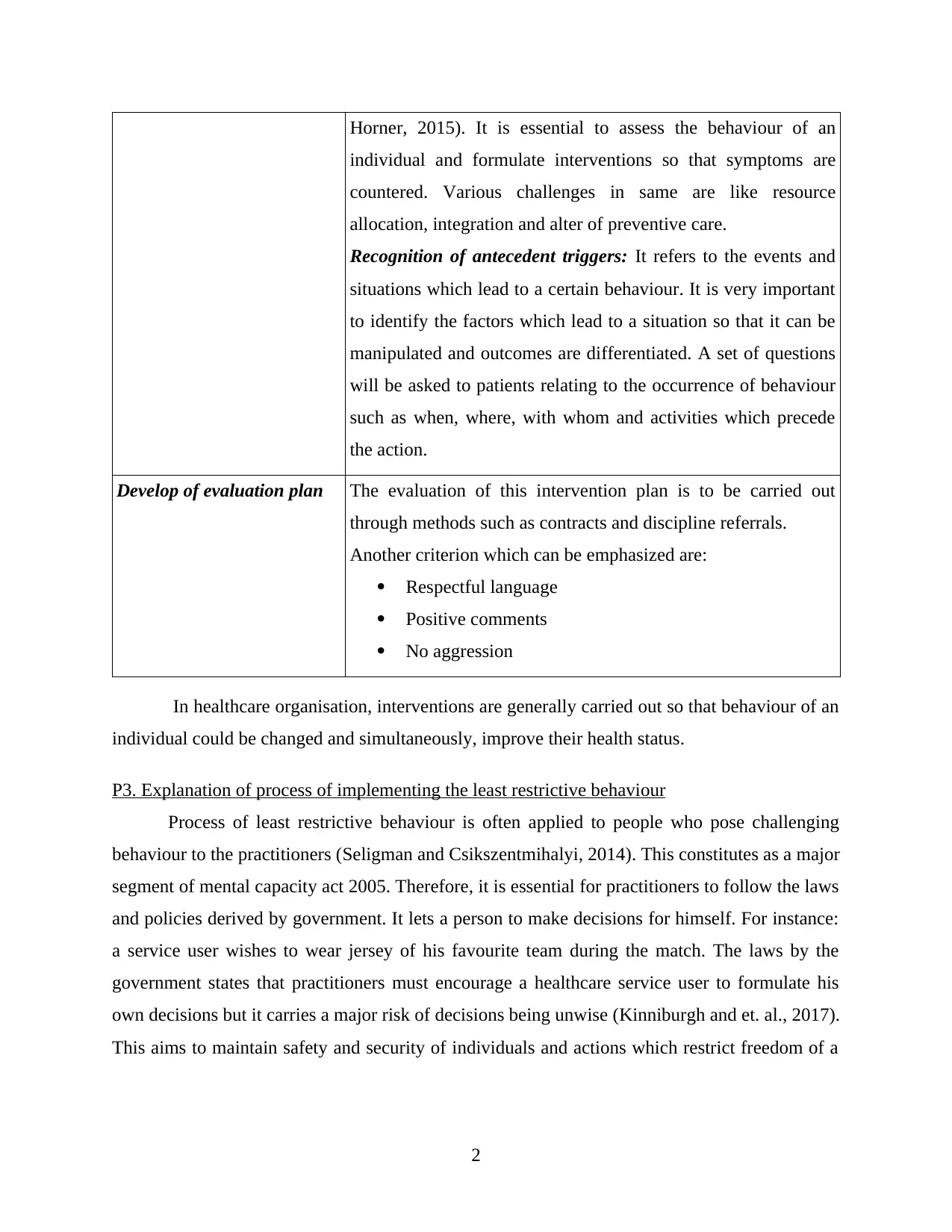
Horner, 2015). It is essential to assess the behaviour of an
individual and formulate interventions so that symptoms are
countered. Various challenges in same are like resource
allocation, integration and alter of preventive care.
Recognition of antecedent triggers: It refers to the events and
situations which lead to a certain behaviour. It is very important
to identify the factors which lead to a situation so that it can be
manipulated and outcomes are differentiated. A set of questions
will be asked to patients relating to the occurrence of behaviour
such as when, where, with whom and activities which precede
the action.
Develop of evaluation plan The evaluation of this intervention plan is to be carried out
through methods such as contracts and discipline referrals.
Another criterion which can be emphasized are:
Respectful language
Positive comments
No aggression
In healthcare organisation, interventions are generally carried out so that behaviour of an
individual could be changed and simultaneously, improve their health status.
P3. Explanation of process of implementing the least restrictive behaviour
Process of least restrictive behaviour is often applied to people who pose challenging
behaviour to the practitioners (Seligman and Csikszentmihalyi, 2014). This constitutes as a major
segment of mental capacity act 2005. Therefore, it is essential for practitioners to follow the laws
and policies derived by government. It lets a person to make decisions for himself. For instance:
a service user wishes to wear jersey of his favourite team during the match. The laws by the
government states that practitioners must encourage a healthcare service user to formulate his
own decisions but it carries a major risk of decisions being unwise (Kinniburgh and et. al., 2017).
This aims to maintain safety and security of individuals and actions which restrict freedom of a
2
individual and formulate interventions so that symptoms are
countered. Various challenges in same are like resource
allocation, integration and alter of preventive care.
Recognition of antecedent triggers: It refers to the events and
situations which lead to a certain behaviour. It is very important
to identify the factors which lead to a situation so that it can be
manipulated and outcomes are differentiated. A set of questions
will be asked to patients relating to the occurrence of behaviour
such as when, where, with whom and activities which precede
the action.
Develop of evaluation plan The evaluation of this intervention plan is to be carried out
through methods such as contracts and discipline referrals.
Another criterion which can be emphasized are:
Respectful language
Positive comments
No aggression
In healthcare organisation, interventions are generally carried out so that behaviour of an
individual could be changed and simultaneously, improve their health status.
P3. Explanation of process of implementing the least restrictive behaviour
Process of least restrictive behaviour is often applied to people who pose challenging
behaviour to the practitioners (Seligman and Csikszentmihalyi, 2014). This constitutes as a major
segment of mental capacity act 2005. Therefore, it is essential for practitioners to follow the laws
and policies derived by government. It lets a person to make decisions for himself. For instance:
a service user wishes to wear jersey of his favourite team during the match. The laws by the
government states that practitioners must encourage a healthcare service user to formulate his
own decisions but it carries a major risk of decisions being unwise (Kinniburgh and et. al., 2017).
This aims to maintain safety and security of individuals and actions which restrict freedom of a
2
Paraphrase This Document
Need a fresh take? Get an instant paraphrase of this document with our AI Paraphraser
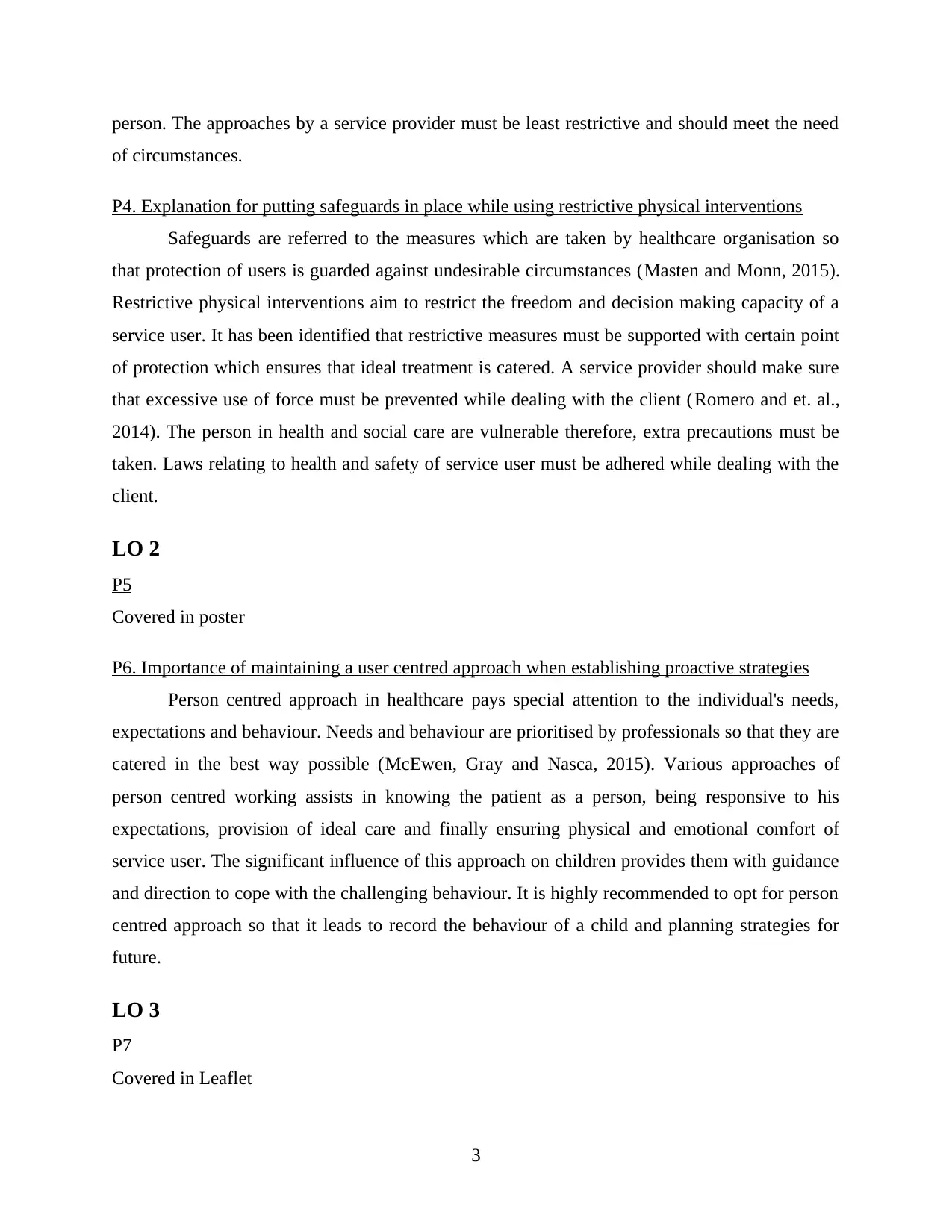
person. The approaches by a service provider must be least restrictive and should meet the need
of circumstances.
P4. Explanation for putting safeguards in place while using restrictive physical interventions
Safeguards are referred to the measures which are taken by healthcare organisation so
that protection of users is guarded against undesirable circumstances (Masten and Monn, 2015).
Restrictive physical interventions aim to restrict the freedom and decision making capacity of a
service user. It has been identified that restrictive measures must be supported with certain point
of protection which ensures that ideal treatment is catered. A service provider should make sure
that excessive use of force must be prevented while dealing with the client (Romero and et. al.,
2014). The person in health and social care are vulnerable therefore, extra precautions must be
taken. Laws relating to health and safety of service user must be adhered while dealing with the
client.
LO 2
P5
Covered in poster
P6. Importance of maintaining a user centred approach when establishing proactive strategies
Person centred approach in healthcare pays special attention to the individual's needs,
expectations and behaviour. Needs and behaviour are prioritised by professionals so that they are
catered in the best way possible (McEwen, Gray and Nasca, 2015). Various approaches of
person centred working assists in knowing the patient as a person, being responsive to his
expectations, provision of ideal care and finally ensuring physical and emotional comfort of
service user. The significant influence of this approach on children provides them with guidance
and direction to cope with the challenging behaviour. It is highly recommended to opt for person
centred approach so that it leads to record the behaviour of a child and planning strategies for
future.
LO 3
P7
Covered in Leaflet
3
of circumstances.
P4. Explanation for putting safeguards in place while using restrictive physical interventions
Safeguards are referred to the measures which are taken by healthcare organisation so
that protection of users is guarded against undesirable circumstances (Masten and Monn, 2015).
Restrictive physical interventions aim to restrict the freedom and decision making capacity of a
service user. It has been identified that restrictive measures must be supported with certain point
of protection which ensures that ideal treatment is catered. A service provider should make sure
that excessive use of force must be prevented while dealing with the client (Romero and et. al.,
2014). The person in health and social care are vulnerable therefore, extra precautions must be
taken. Laws relating to health and safety of service user must be adhered while dealing with the
client.
LO 2
P5
Covered in poster
P6. Importance of maintaining a user centred approach when establishing proactive strategies
Person centred approach in healthcare pays special attention to the individual's needs,
expectations and behaviour. Needs and behaviour are prioritised by professionals so that they are
catered in the best way possible (McEwen, Gray and Nasca, 2015). Various approaches of
person centred working assists in knowing the patient as a person, being responsive to his
expectations, provision of ideal care and finally ensuring physical and emotional comfort of
service user. The significant influence of this approach on children provides them with guidance
and direction to cope with the challenging behaviour. It is highly recommended to opt for person
centred approach so that it leads to record the behaviour of a child and planning strategies for
future.
LO 3
P7
Covered in Leaflet
3
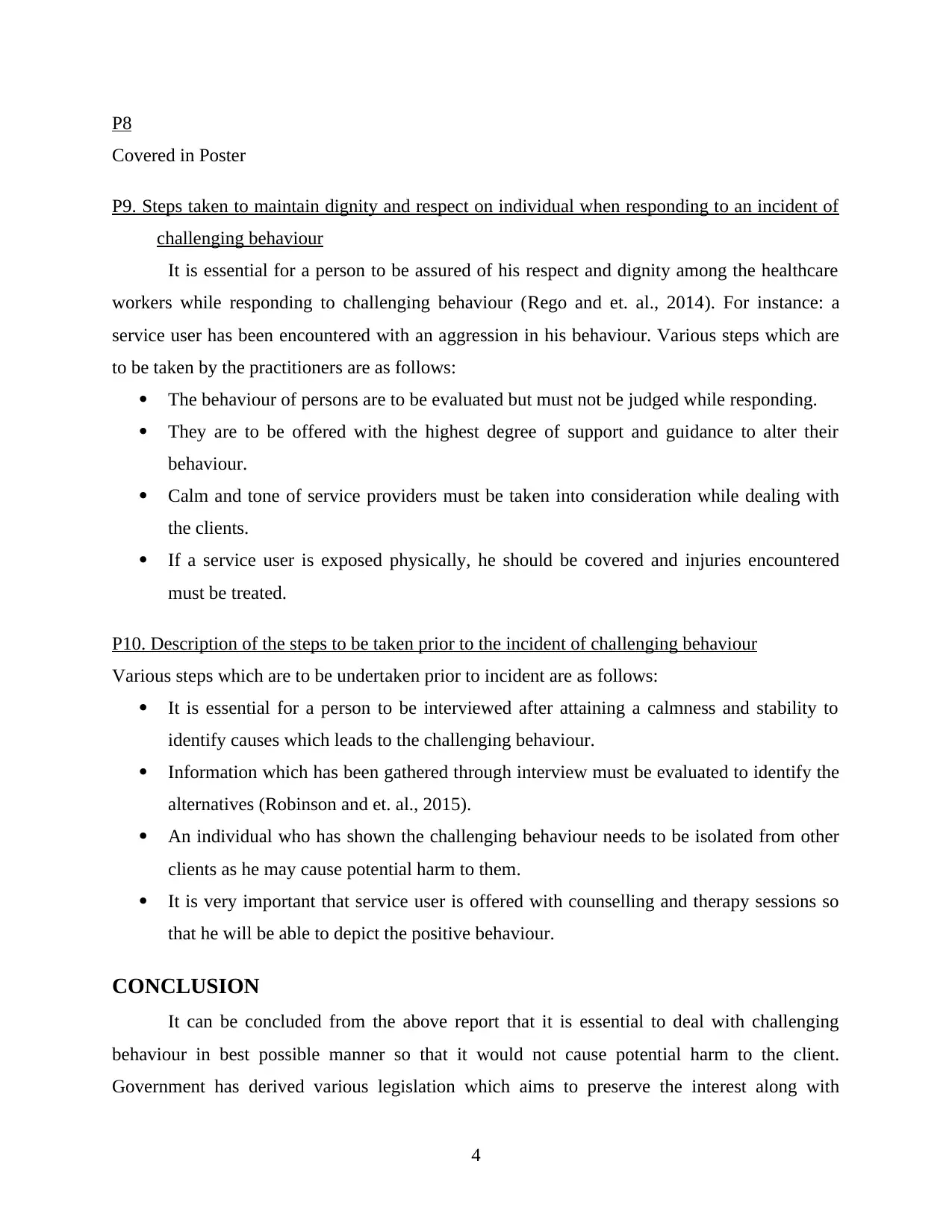
P8
Covered in Poster
P9. Steps taken to maintain dignity and respect on individual when responding to an incident of
challenging behaviour
It is essential for a person to be assured of his respect and dignity among the healthcare
workers while responding to challenging behaviour (Rego and et. al., 2014). For instance: a
service user has been encountered with an aggression in his behaviour. Various steps which are
to be taken by the practitioners are as follows:
The behaviour of persons are to be evaluated but must not be judged while responding.
They are to be offered with the highest degree of support and guidance to alter their
behaviour.
Calm and tone of service providers must be taken into consideration while dealing with
the clients.
If a service user is exposed physically, he should be covered and injuries encountered
must be treated.
P10. Description of the steps to be taken prior to the incident of challenging behaviour
Various steps which are to be undertaken prior to incident are as follows:
It is essential for a person to be interviewed after attaining a calmness and stability to
identify causes which leads to the challenging behaviour.
Information which has been gathered through interview must be evaluated to identify the
alternatives (Robinson and et. al., 2015).
An individual who has shown the challenging behaviour needs to be isolated from other
clients as he may cause potential harm to them.
It is very important that service user is offered with counselling and therapy sessions so
that he will be able to depict the positive behaviour.
CONCLUSION
It can be concluded from the above report that it is essential to deal with challenging
behaviour in best possible manner so that it would not cause potential harm to the client.
Government has derived various legislation which aims to preserve the interest along with
4
Covered in Poster
P9. Steps taken to maintain dignity and respect on individual when responding to an incident of
challenging behaviour
It is essential for a person to be assured of his respect and dignity among the healthcare
workers while responding to challenging behaviour (Rego and et. al., 2014). For instance: a
service user has been encountered with an aggression in his behaviour. Various steps which are
to be taken by the practitioners are as follows:
The behaviour of persons are to be evaluated but must not be judged while responding.
They are to be offered with the highest degree of support and guidance to alter their
behaviour.
Calm and tone of service providers must be taken into consideration while dealing with
the clients.
If a service user is exposed physically, he should be covered and injuries encountered
must be treated.
P10. Description of the steps to be taken prior to the incident of challenging behaviour
Various steps which are to be undertaken prior to incident are as follows:
It is essential for a person to be interviewed after attaining a calmness and stability to
identify causes which leads to the challenging behaviour.
Information which has been gathered through interview must be evaluated to identify the
alternatives (Robinson and et. al., 2015).
An individual who has shown the challenging behaviour needs to be isolated from other
clients as he may cause potential harm to them.
It is very important that service user is offered with counselling and therapy sessions so
that he will be able to depict the positive behaviour.
CONCLUSION
It can be concluded from the above report that it is essential to deal with challenging
behaviour in best possible manner so that it would not cause potential harm to the client.
Government has derived various legislation which aims to preserve the interest along with
4
⊘ This is a preview!⊘
Do you want full access?
Subscribe today to unlock all pages.

Trusted by 1+ million students worldwide
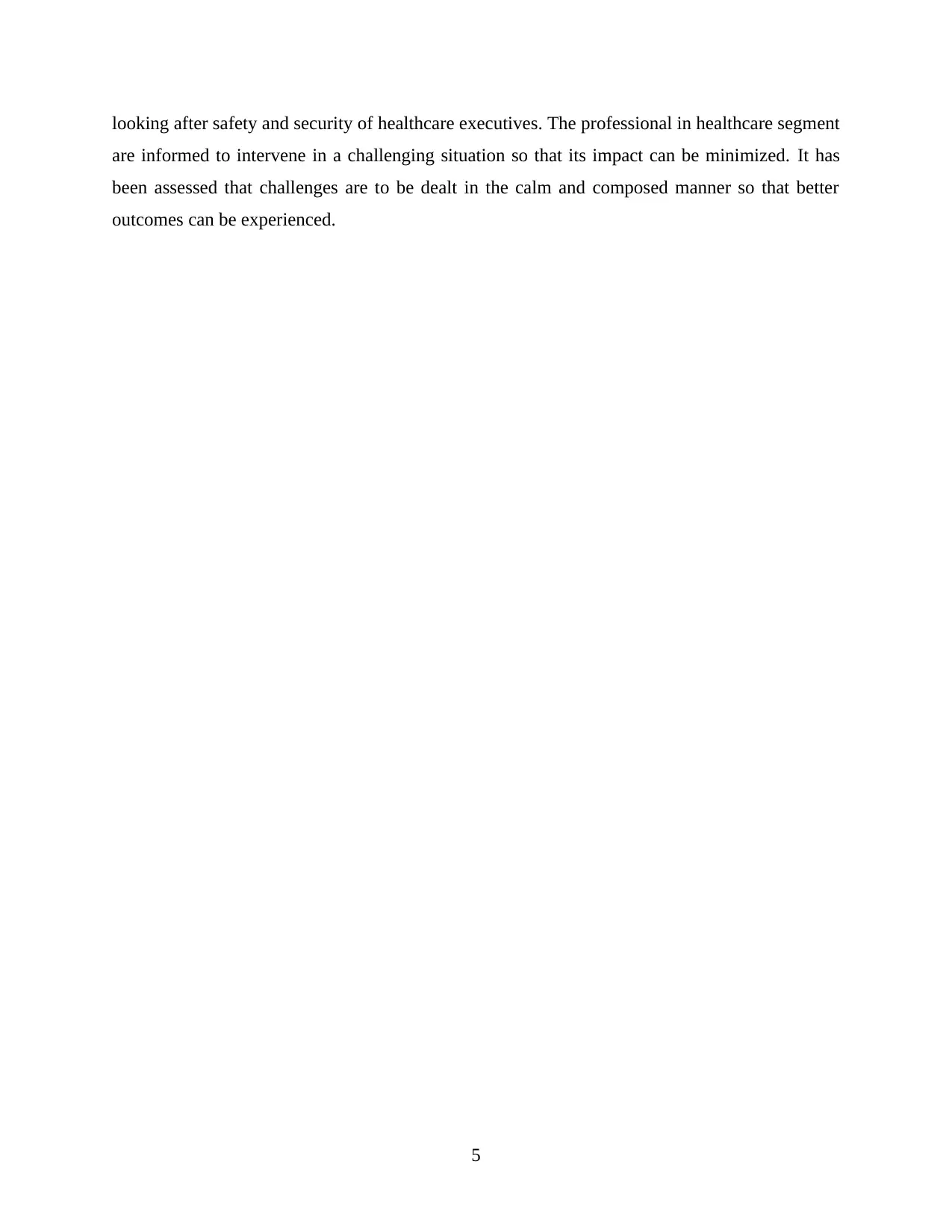
looking after safety and security of healthcare executives. The professional in healthcare segment
are informed to intervene in a challenging situation so that its impact can be minimized. It has
been assessed that challenges are to be dealt in the calm and composed manner so that better
outcomes can be experienced.
5
are informed to intervene in a challenging situation so that its impact can be minimized. It has
been assessed that challenges are to be dealt in the calm and composed manner so that better
outcomes can be experienced.
5
Paraphrase This Document
Need a fresh take? Get an instant paraphrase of this document with our AI Paraphraser
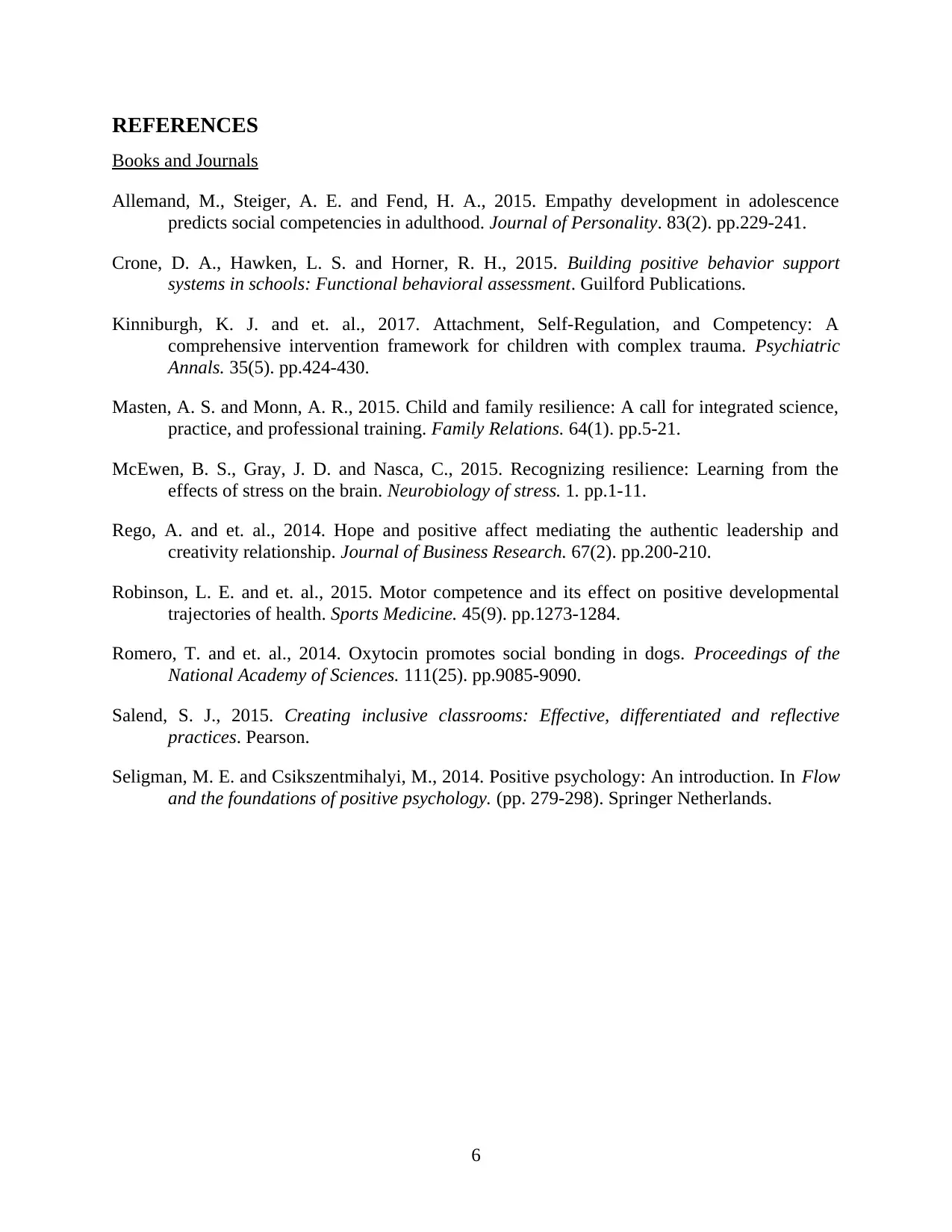
REFERENCES
Books and Journals
Allemand, M., Steiger, A. E. and Fend, H. A., 2015. Empathy development in adolescence
predicts social competencies in adulthood. Journal of Personality. 83(2). pp.229-241.
Crone, D. A., Hawken, L. S. and Horner, R. H., 2015. Building positive behavior support
systems in schools: Functional behavioral assessment. Guilford Publications.
Kinniburgh, K. J. and et. al., 2017. Attachment, Self-Regulation, and Competency: A
comprehensive intervention framework for children with complex trauma. Psychiatric
Annals. 35(5). pp.424-430.
Masten, A. S. and Monn, A. R., 2015. Child and family resilience: A call for integrated science,
practice, and professional training. Family Relations. 64(1). pp.5-21.
McEwen, B. S., Gray, J. D. and Nasca, C., 2015. Recognizing resilience: Learning from the
effects of stress on the brain. Neurobiology of stress. 1. pp.1-11.
Rego, A. and et. al., 2014. Hope and positive affect mediating the authentic leadership and
creativity relationship. Journal of Business Research. 67(2). pp.200-210.
Robinson, L. E. and et. al., 2015. Motor competence and its effect on positive developmental
trajectories of health. Sports Medicine. 45(9). pp.1273-1284.
Romero, T. and et. al., 2014. Oxytocin promotes social bonding in dogs. Proceedings of the
National Academy of Sciences. 111(25). pp.9085-9090.
Salend, S. J., 2015. Creating inclusive classrooms: Effective, differentiated and reflective
practices. Pearson.
Seligman, M. E. and Csikszentmihalyi, M., 2014. Positive psychology: An introduction. In Flow
and the foundations of positive psychology. (pp. 279-298). Springer Netherlands.
6
Books and Journals
Allemand, M., Steiger, A. E. and Fend, H. A., 2015. Empathy development in adolescence
predicts social competencies in adulthood. Journal of Personality. 83(2). pp.229-241.
Crone, D. A., Hawken, L. S. and Horner, R. H., 2015. Building positive behavior support
systems in schools: Functional behavioral assessment. Guilford Publications.
Kinniburgh, K. J. and et. al., 2017. Attachment, Self-Regulation, and Competency: A
comprehensive intervention framework for children with complex trauma. Psychiatric
Annals. 35(5). pp.424-430.
Masten, A. S. and Monn, A. R., 2015. Child and family resilience: A call for integrated science,
practice, and professional training. Family Relations. 64(1). pp.5-21.
McEwen, B. S., Gray, J. D. and Nasca, C., 2015. Recognizing resilience: Learning from the
effects of stress on the brain. Neurobiology of stress. 1. pp.1-11.
Rego, A. and et. al., 2014. Hope and positive affect mediating the authentic leadership and
creativity relationship. Journal of Business Research. 67(2). pp.200-210.
Robinson, L. E. and et. al., 2015. Motor competence and its effect on positive developmental
trajectories of health. Sports Medicine. 45(9). pp.1273-1284.
Romero, T. and et. al., 2014. Oxytocin promotes social bonding in dogs. Proceedings of the
National Academy of Sciences. 111(25). pp.9085-9090.
Salend, S. J., 2015. Creating inclusive classrooms: Effective, differentiated and reflective
practices. Pearson.
Seligman, M. E. and Csikszentmihalyi, M., 2014. Positive psychology: An introduction. In Flow
and the foundations of positive psychology. (pp. 279-298). Springer Netherlands.
6
1 out of 8
Related Documents
Your All-in-One AI-Powered Toolkit for Academic Success.
+13062052269
info@desklib.com
Available 24*7 on WhatsApp / Email
![[object Object]](/_next/static/media/star-bottom.7253800d.svg)
Unlock your academic potential
Copyright © 2020–2025 A2Z Services. All Rights Reserved. Developed and managed by ZUCOL.





